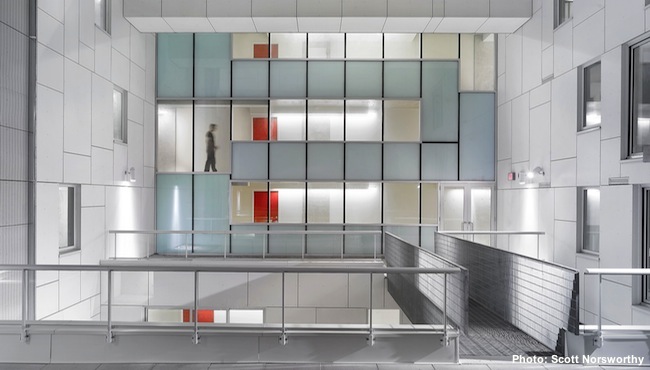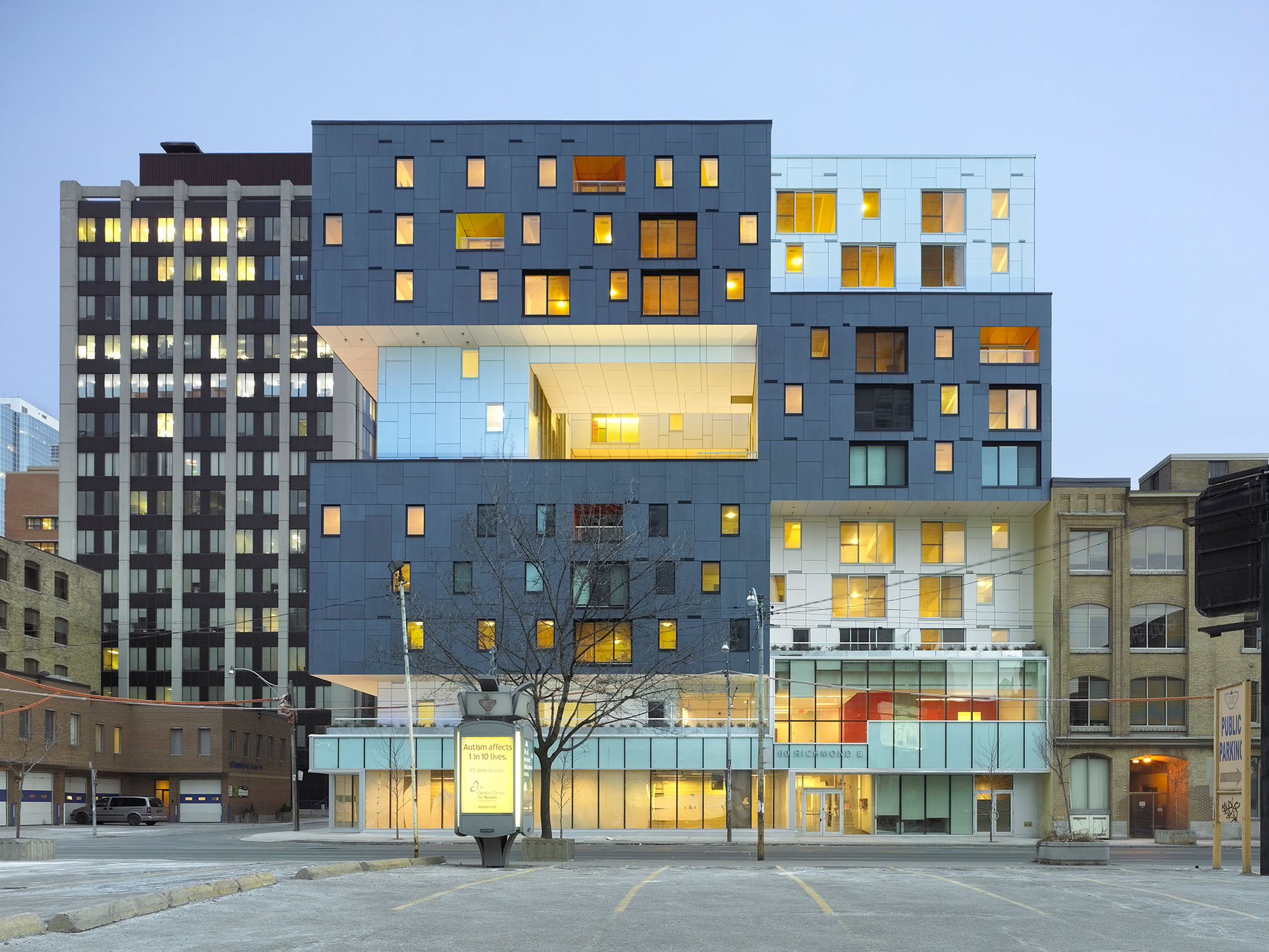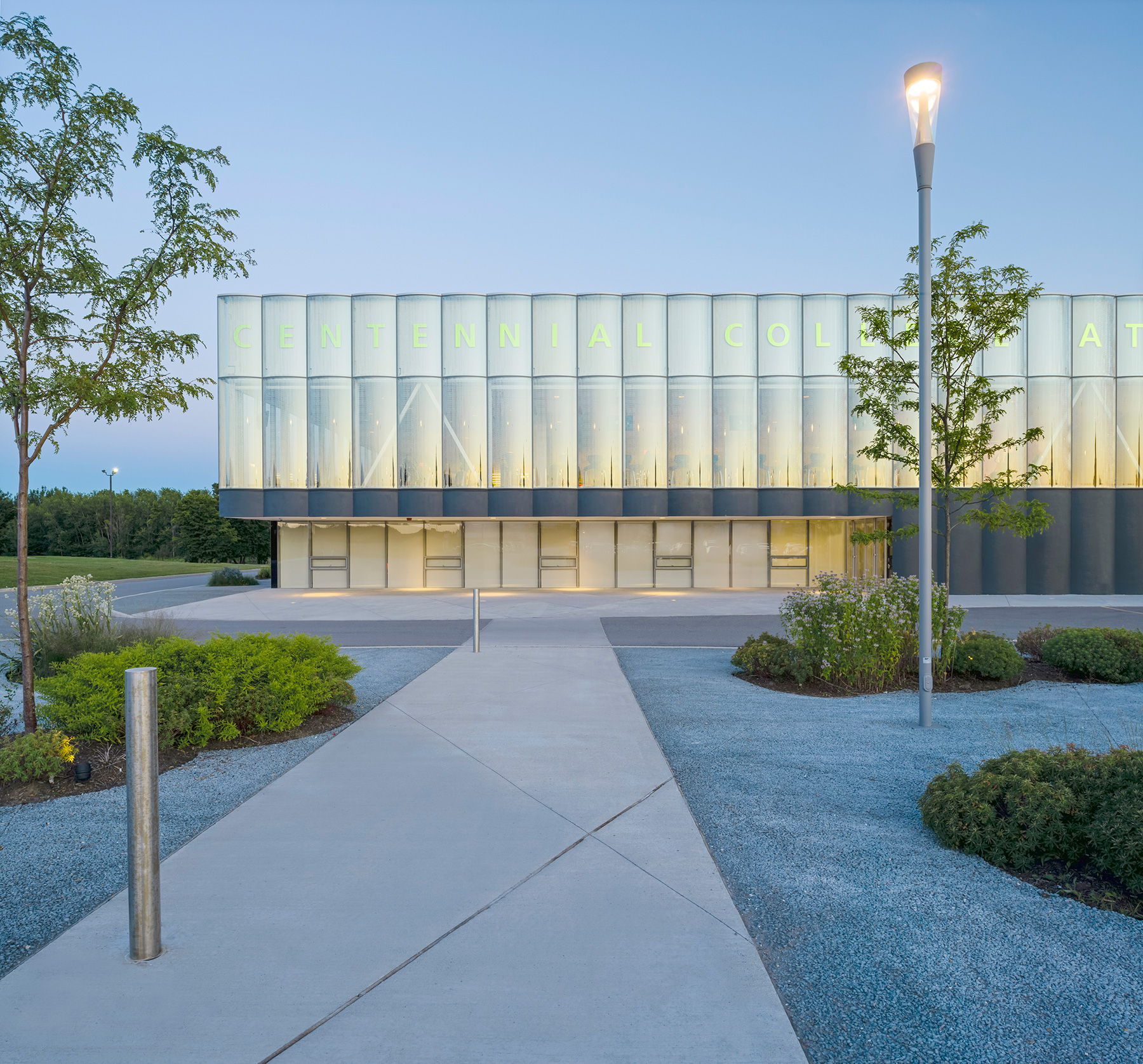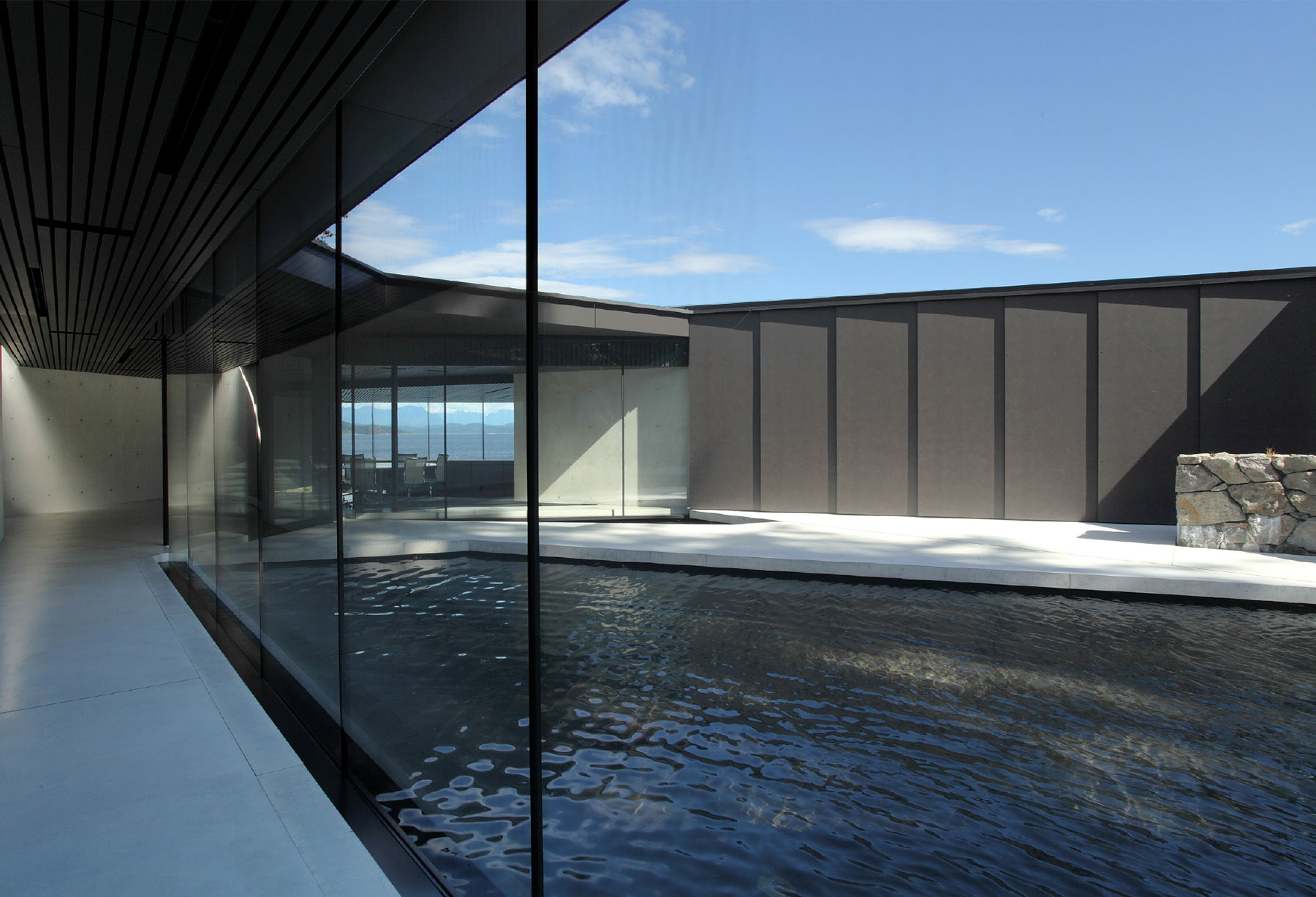The Canada Council for the Arts and RAIC | Architecture Canada announced the recipients of the Governor General’s Medals in Architecture.
The awards celebrate outstanding design in recently completed projects by Canadian architects.
The winning buildings reflect excellence in sustainable design, innovation, and compatibility with the landscape.
Eleven of the 12 buildings selected this year were built to enhance community life. Projects include cooperative housing, university buildings, a city hall, a community centre, an outdoor stage and two libraries.
The 2014 winners include:
1. 60 Richmond East Housing Co-Operative, Toronto
Teeple Architects Inc.
Located in downtown Toronto, this LEED Gold housing co-operative provides an alternative to the ubiquitous local glass towers. Terraces are carved out of the building’s solid mass to create social spaces and gardens on various levels. The project houses relocated hospitality workers from Regent Park, a deteriorating social-housing community undergoing redevelopment.
The residents operate a restaurant and training kitchen on the ground floor and a community garden on the sixth-floor terrace. The garden provides food for the restaurant and uses organic waste generated by the kitchens as compost. This creates a self-sustaining condition called “urban permaculture.”
Jury Comment:
"This is a socially admirable project that very much transcends the type and stands as an exemplar for urban housing. The building design takes apart the various program components and recombines them into a complex, sustainable and very urban hive of neighborhoods. It is extremely gratifying to see a social housing project rise so far above mere accommodation."
2. Centennial College Athletic and Wellness Centre, Toronto
Kongats Architects
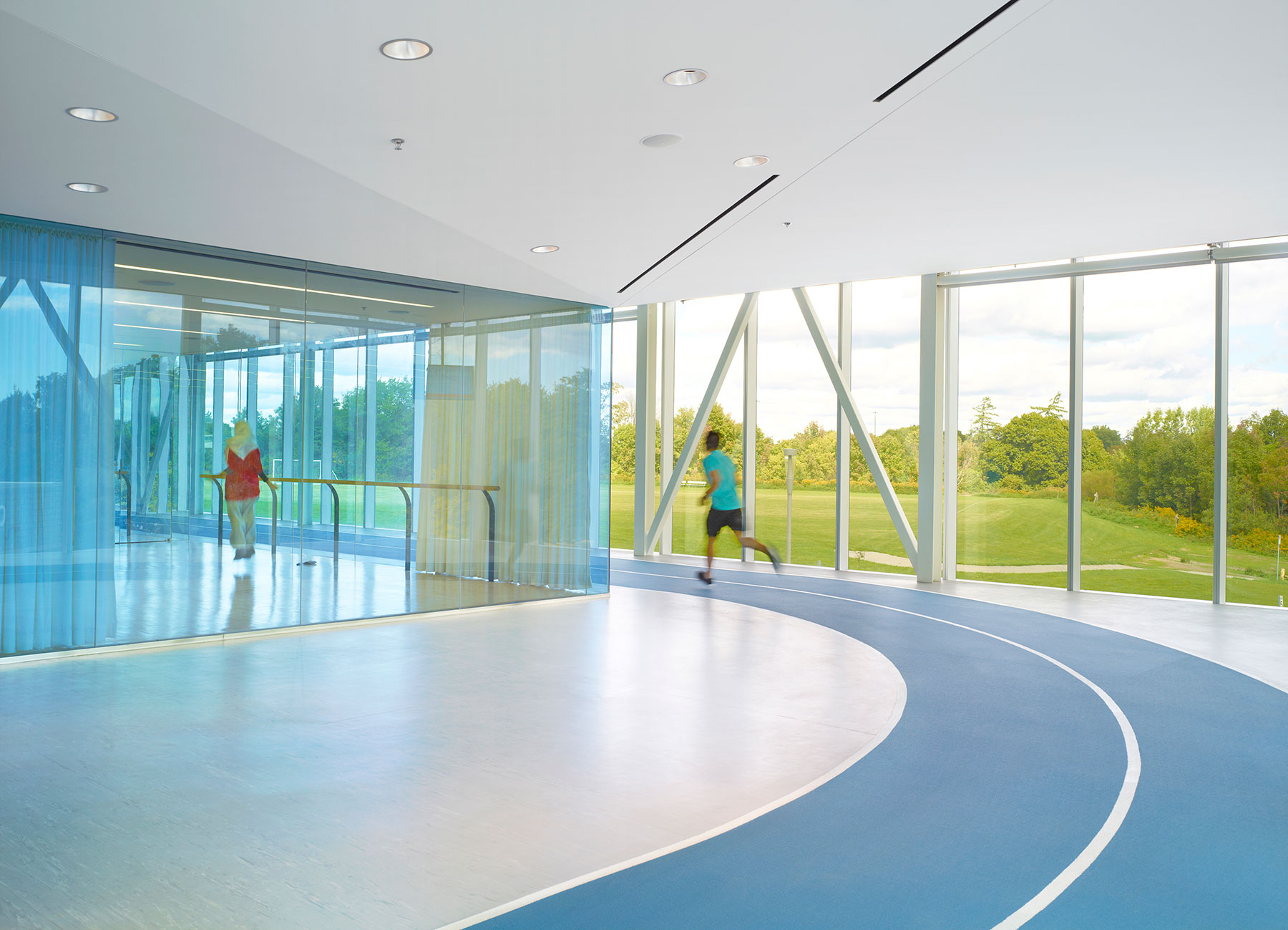
Photo: Shai Gil
The Centennial College Athletic and Wellness Centre redevelops an existing gymnasium facility to create a central athletic centre for Centennial College. The new centre accommodates multiple programs – both athletic and academic. It also provides a venue for the college’s annual convocation ceremonies and student association concerts and events.
Added to the project scope was the re-design of the interstitial campus grounds to create the Centennial College Alumni Courtyard. The courtyard provides the college community with durable and accessible connections between the campus buildings and useful places for gathering and reflection.
Jury Comment:
"Of the award winners, this project is singular in developing an architecture of enclosure, by way of an innovative glass and concrete envelope. It brings a minimal, and elegant resolution to both the fitness facility inside and the grounds outside. The façade’s curved glass surface generates unique perceptual effects and magnifies the transformations in ambient light and atmosphere. Its articulation replays classical principles of a heavy base, column-like elements, and crown."

Photo: Double Space

Photo: Double Space
3. Centre for International Governance Innovation Campus, Waterloo, Ont.
KPMB Architects
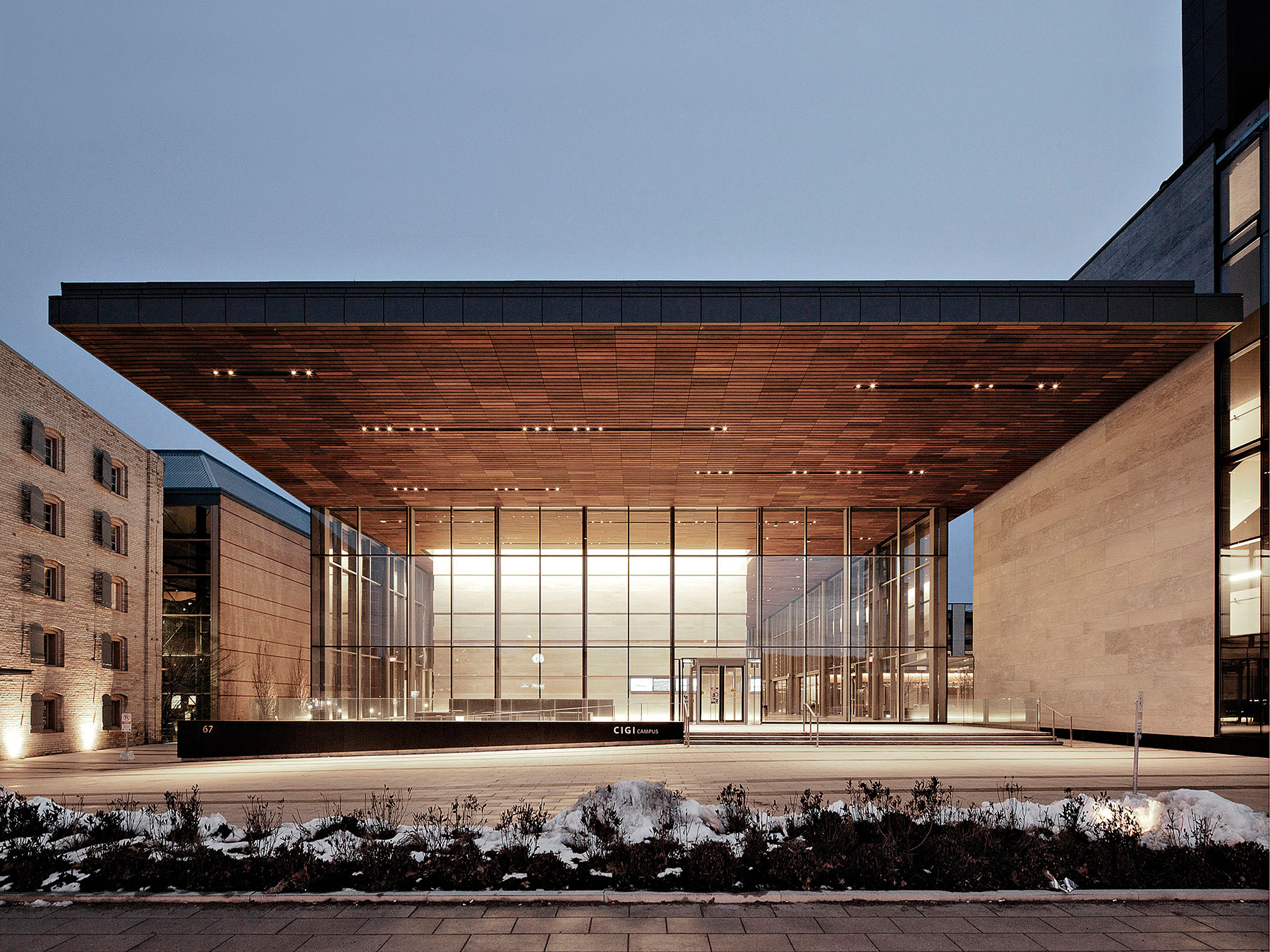
Photo: © Maris Mezulis
The CIGI campus transforms the historic Seagram distillery, the only site in Canada surrounded by three Governor-General-Award-winning projects, into a think tank on international governance. The design presents a contemporary interpretation of the academic quad with three interconnected buildings organized around a courtyard.
A two-storey glass pavilion with an entrance canopy and bell tower marks the main public entrance and contains the auditorium. The massing and expression were designed to relate to the heritage context of the area’s 19th-century industrial fabric. A key element in Waterloo’s revitalization vision, the project demonstrates the benefit of architecture.
Jury Comment:
"The jury salutes the elegant restraint of this project. Its roof overhang attracts the eye without being attention-grabbing; it calmly engages its patrimonial neighbour and prefigures the physical comfort to come, inside. Careful use of materials evokes a sense of comfort and longevity. A well-proportioned landscaped courtyard furthers the serenity and liveability of the center. A profoundly humane environment is achieved."

Photo: © Maris Mezulis

Photo: © Tom Arban

Photo: © Maris Mezulis
4. Faculty of Pharmaceutical Sciences and Centre for Drug Research and Development, University of British Columbia, Vancouver
Saucier + Perrotte Architectes / Hughes Condon Marler Architects
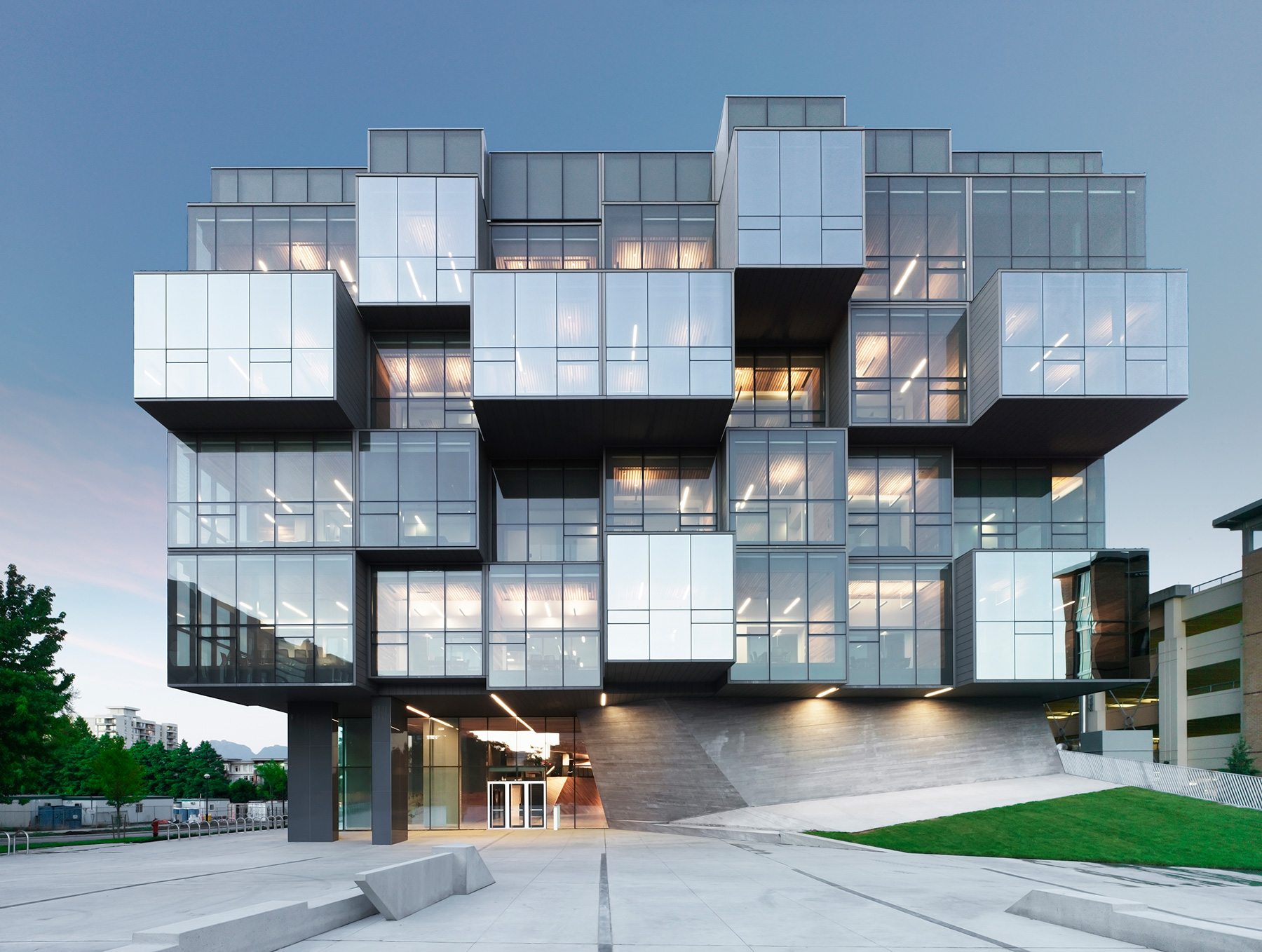
All photos: Marc Cramer
The design of the state-of-the-art Faculty of Pharmaceutical Sciences and Centre for Drug Research and Development focuses on enjoyable, livable and sustainable spaces for research and learning. The architecture has a striking presence on campus, functioning as a gateway to the academic core.
Serving as an allegory for the development of modern medicine, the design concept relates to two trees whose foliage becomes fused into an extensive network of branches. To successfully contribute to UBC’s legacy of architecture and pharmaceutical research, the project develops a sustainable, signature design so as to provide a benchmark for education and research buildings.
Jury Comment:
"A strong building with a strong concept, beautifully executed. A richly textured, angular base supports a polished, orthogonal building. A deeply articulated main façade contrasts with the side walls. Special attention is paid to users, both in terms of quality of light as well as opportunities to meet and socialize. On both counts of liveability and architectural expressiveness, this project brings a human dimension to a highly technical program."
5. Joseph L. Rotman School of Management Expansion, University of Toronto
KPMB Architects
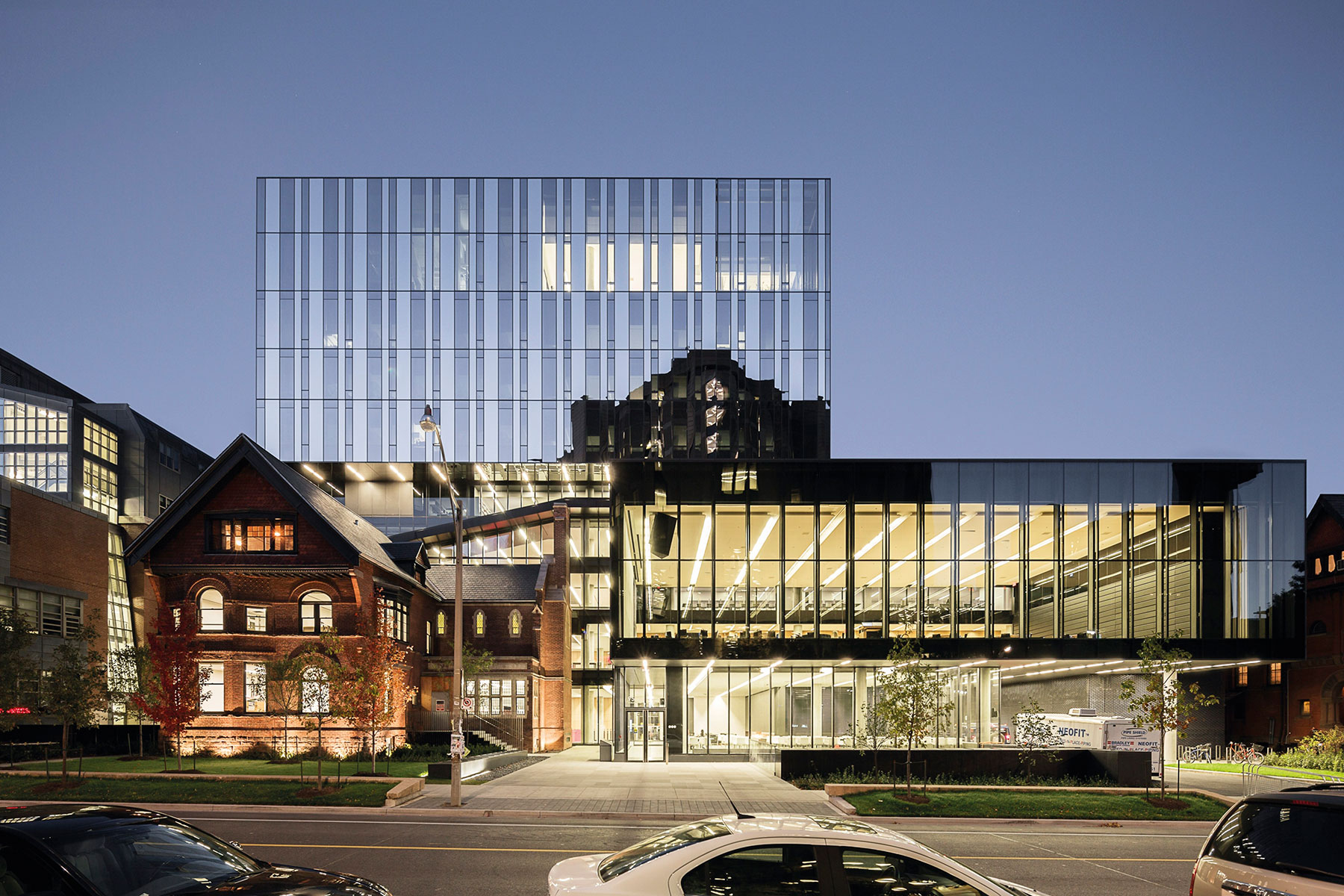
Photo: © Maris Mezulis
The vertical, interconnected campus is an expression of Rotman’s core mission to promote the power of creativity and integrative thinking. The design fuses ideas of campus and city-building, study and interaction, sustainable design, creativity and business strategy. Conceived through the lens of Rotman’s Integrative Thinking program, the design encapsulates the power of architecture to harmonize seemingly opposite notions and objectives at every scale of design.
The expansion creates a vibrant global hub in which to advance its curriculum. It reinforces the necessity of architectural excellence to inspire growth in education to ensure Canada remains competitive in the global marketplace.
Jury Comment:
"Large glass volumes are anchored to an existing Victorian house and seem to float behind it. The volumes are simple and their detailing well-controlled, giving this building a sense of refinement and solidity. The lipstick-pink line of a staircase spirals up and down their core, to act as a social condenser and tease out the element of creation and innovation inherent in the school philosophy. This bright gesture in a sober box, along with the light volumes against the stately mansion, make a convincing use of contrasts."

Photo: © Maris Mezulis

Photo: © Tom Arban

Photo: © Tom Arban
6. Mies van der Rohe gas station, Verdun, Quebec
Les Architectes FABG

All photos: Steve Montpetit
The Mies van der Rohe gas station on Nuns’ Island ceased commercial operation in 2008. The City of Montreal listed it as a heritage building in 2009 before initiating the project of a youth and senior activity centre. This simple program requires an open space for each group to congregate and participate in communal activities.
The project is not about the faithful restoration of a monument. It is an interpretation. It tries to communicate the essence of an artistic vision, formulated by someone else in response to a world that is no longer the same. Musicians do this every day.
Jury Comment:
"This superb reinterpretation of Mies van der Rohe’s prototype gas station brings an end to years of relative neglect. The precise, essential reinvention of this structure as a community space is quite beautiful, right down to the mechanical servicing that reprises the gas pumps of the original. One might imagine that Mies would be happily surprised. It is a restoration without being a slavish reconstruction."
7. North Vancouver City Hall
Michael Green Architecture
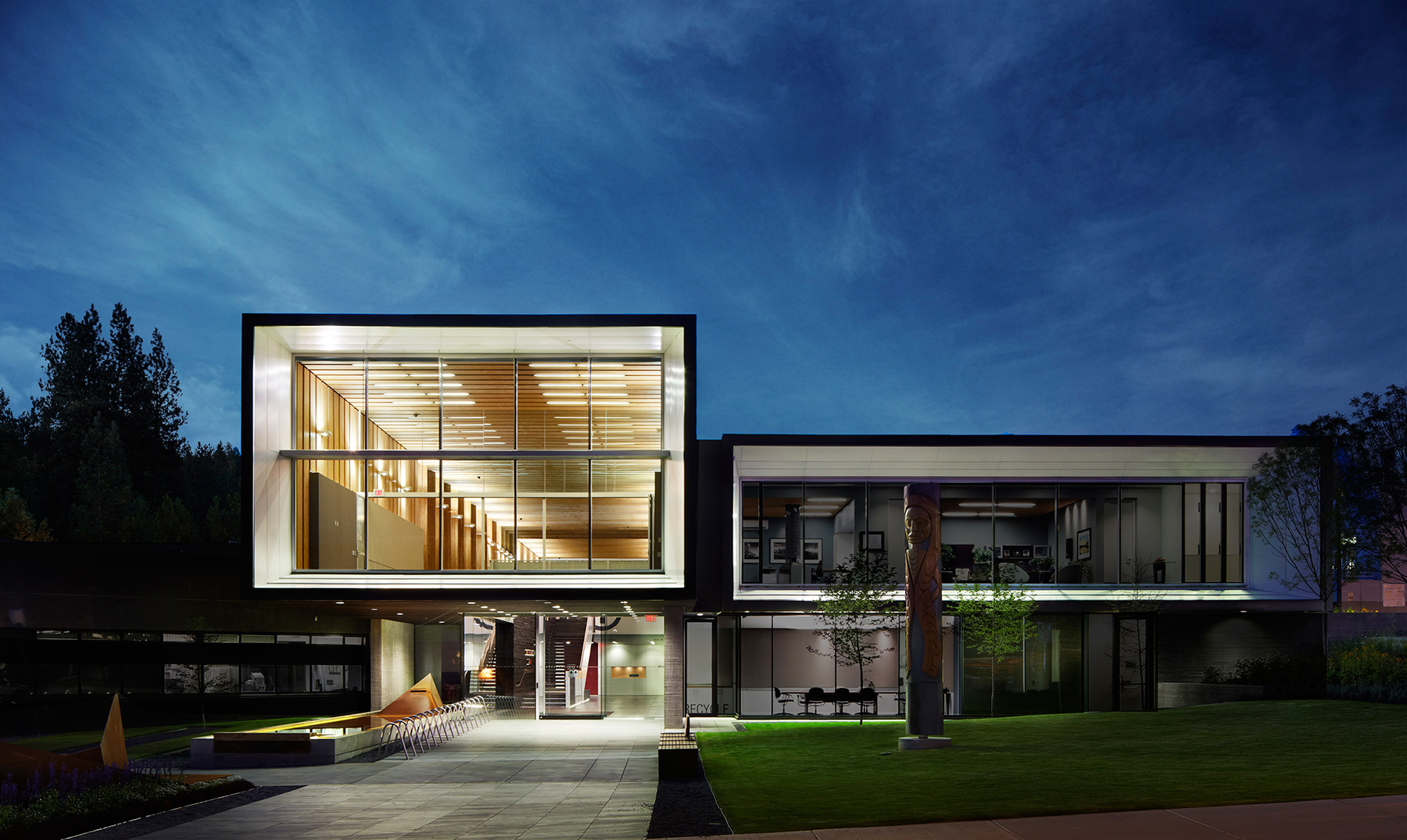
Photo: Martin Tessler
The North Vancouver City Hall project revitalizes an existing modern-heritage municipal building with a significant addition of public space, staff offices and meeting rooms. The project features an innovative mass-timber structure within a 220-foot long atrium. The structure knits together the existing building with an adjacent vacated library.
The project upgrades structural and environmental performance. Careful attention was given to public and staff amenities and the flow of public space from inside to out. The design illustrates a successful restoration through the use of structural wood. A clear spatial design results in elegant public architecture.
Jury Comment:
"An elegant, restrained and sophisticated expansion to a small district municipal hall. A simple and engaging tube-like structure is inserted between two existing buildings, to act as a common entry point. The vocabulary is warm and refined, befitting a city hall’s place in the community."
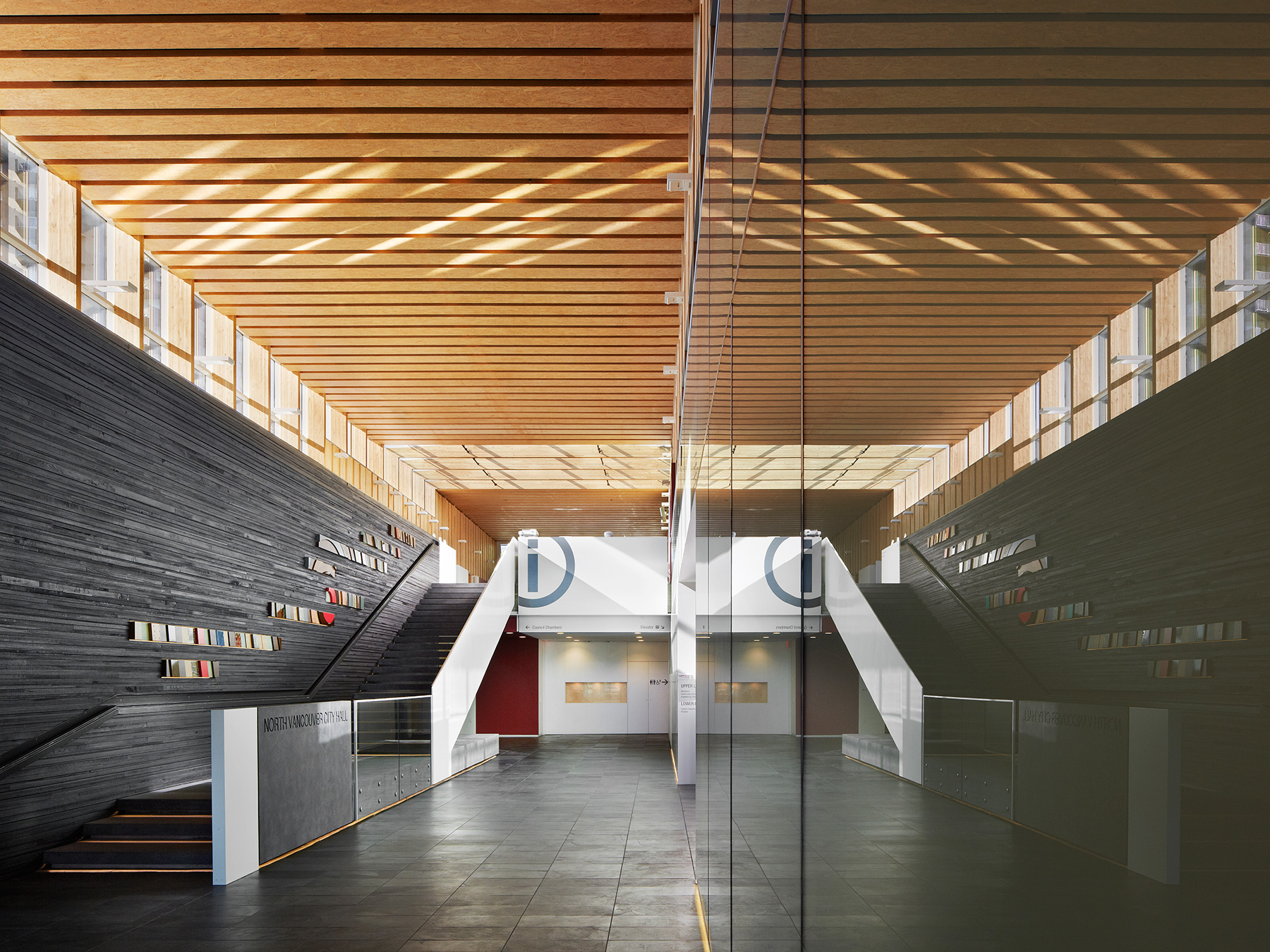
Photo: Martin Tessler
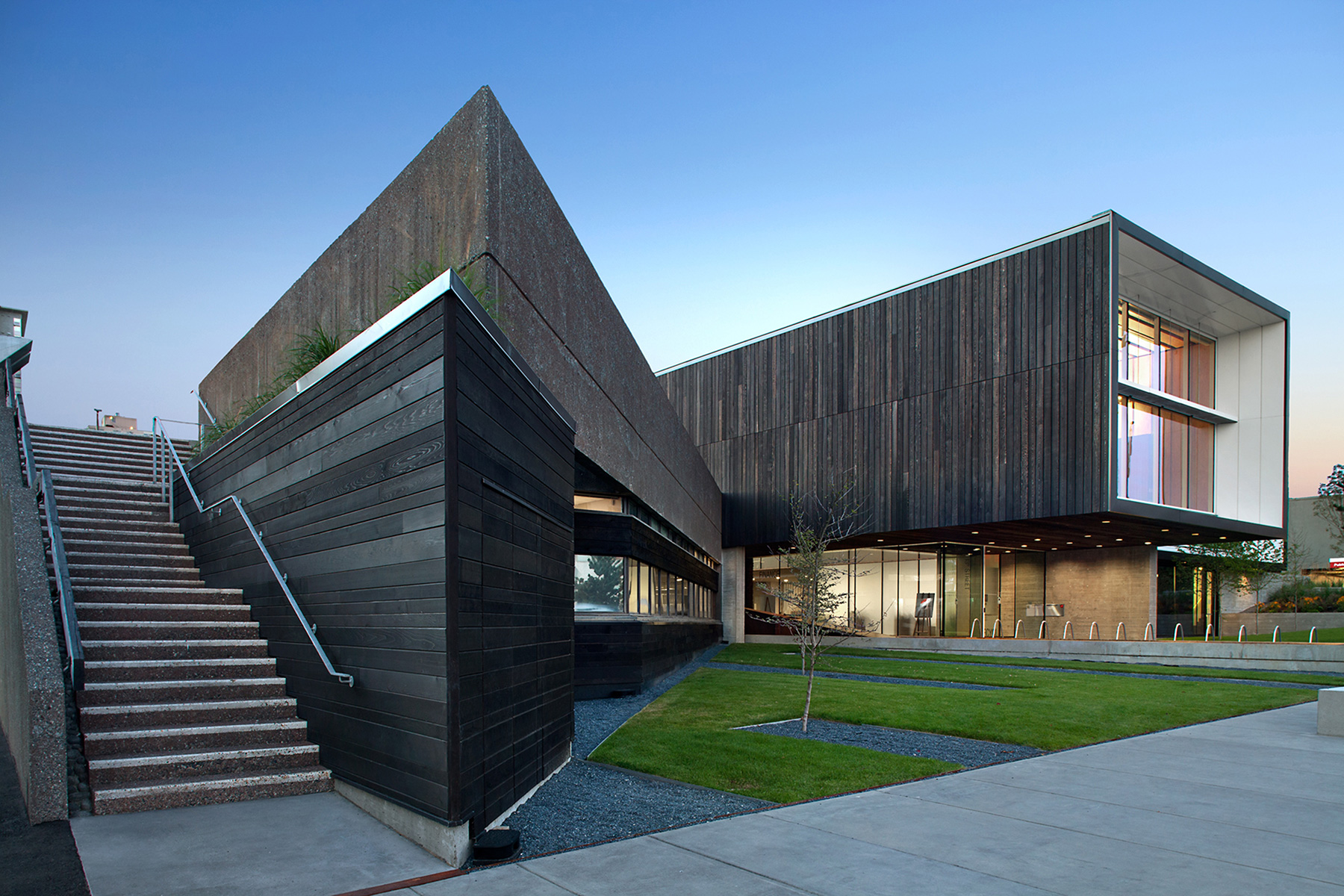
Photo: Ema Peter
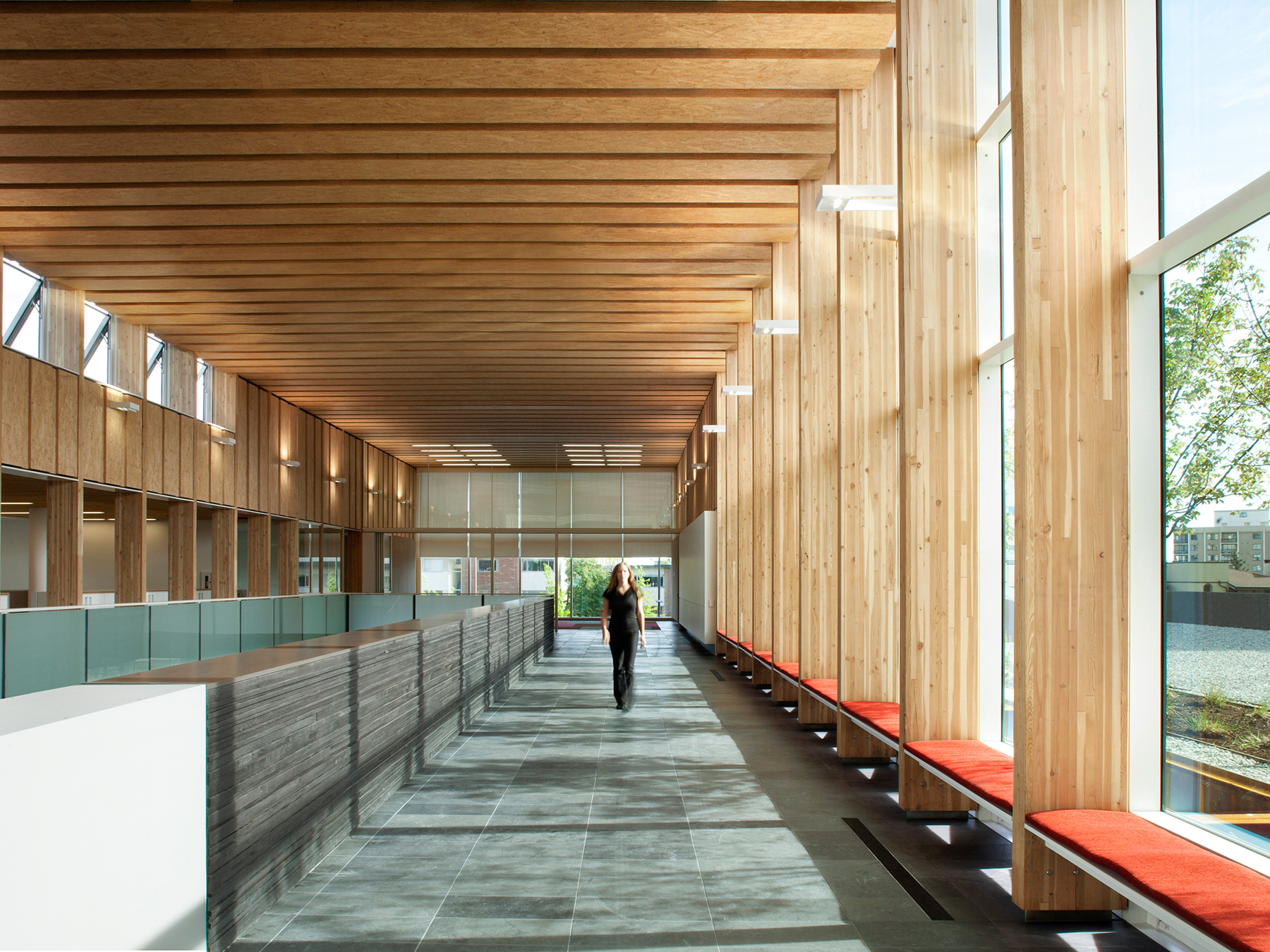
Photo: Ema Peter
8. OMS Stage, Winnipeg
5468796 Architecture Inc.
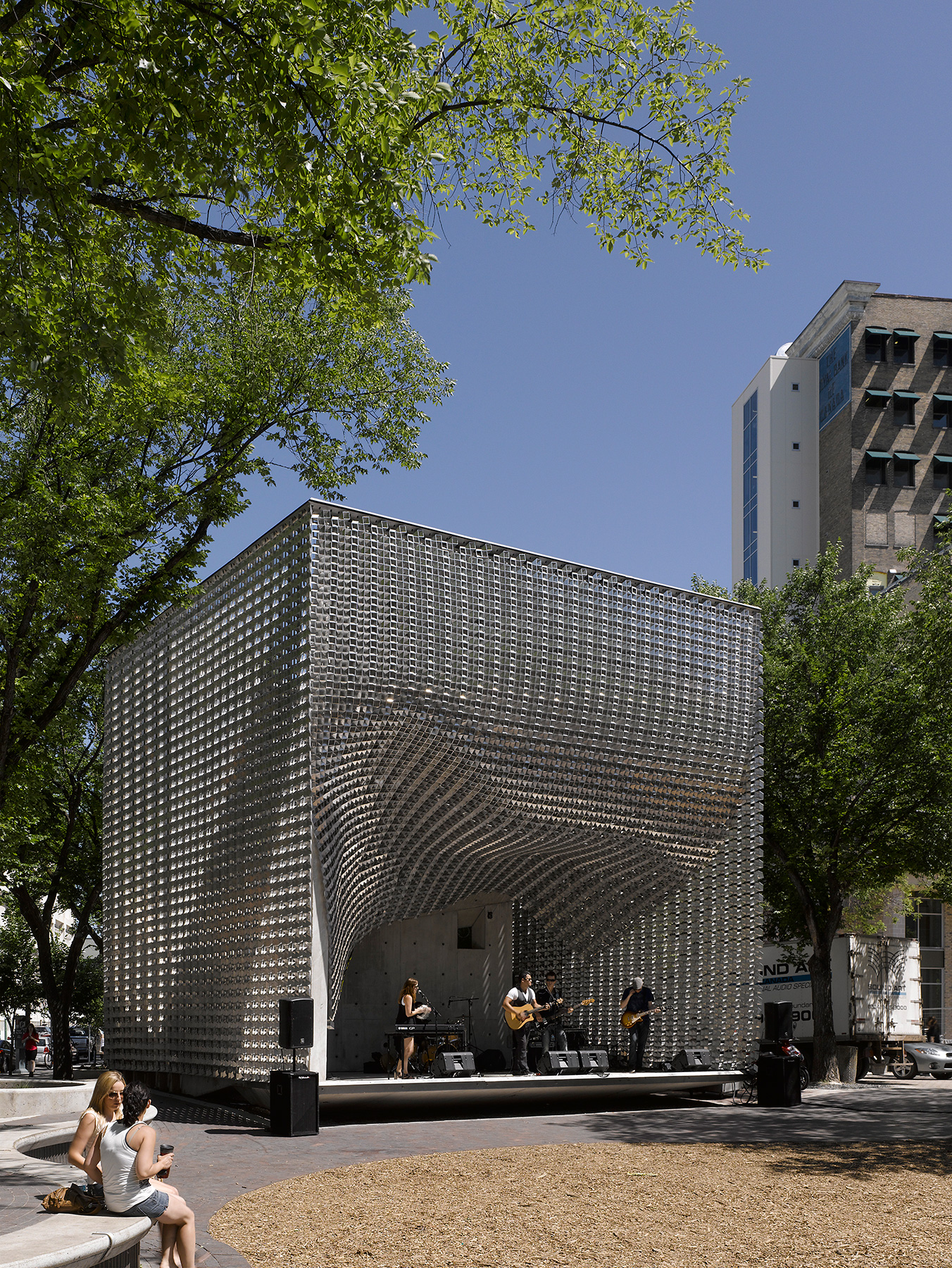
Photo: James Brittain Photography
OMS Stage (“The Cube”) is an open-air performance venue in Old Market Square, a green space and summer festival hub in Winnipeg’s historic Exchange District. A concrete structure enclosed by a flexible metal skin, the stage is a year-round public amenity. The membrane is composed of 20,000 identical hollow aluminum pieces strung together on aircraft cables.
The orientation of the pieces alternates, forming a malleable and shimmering curtain that can stand like a wall, pull in to reveal the performance space, or function as a light-refracting surface. It is a projection screen, concert venue, shelter and sculptural object.
Jury Comment:
"A small urban gesture but a large contribution to the city. This building works on many levels: as sculpture, performing stage, folly and meeting place. Its innovative and flexible design allows for constant transformation to accommodate a variety of programs and activities, year round. It expands the realm of possibilities associated with a band stand and is a shining reminder of the architect’s responsibility to animate the public realm."

Photo: 5468796 Architecture

Photo: James Brittain Photography

Photo: James Brittain Photography
9. Raymond-Lévesque Public Library, Saint-Hubert, Quebec
Atelier TAG / Jodoin Lamarre Pratte
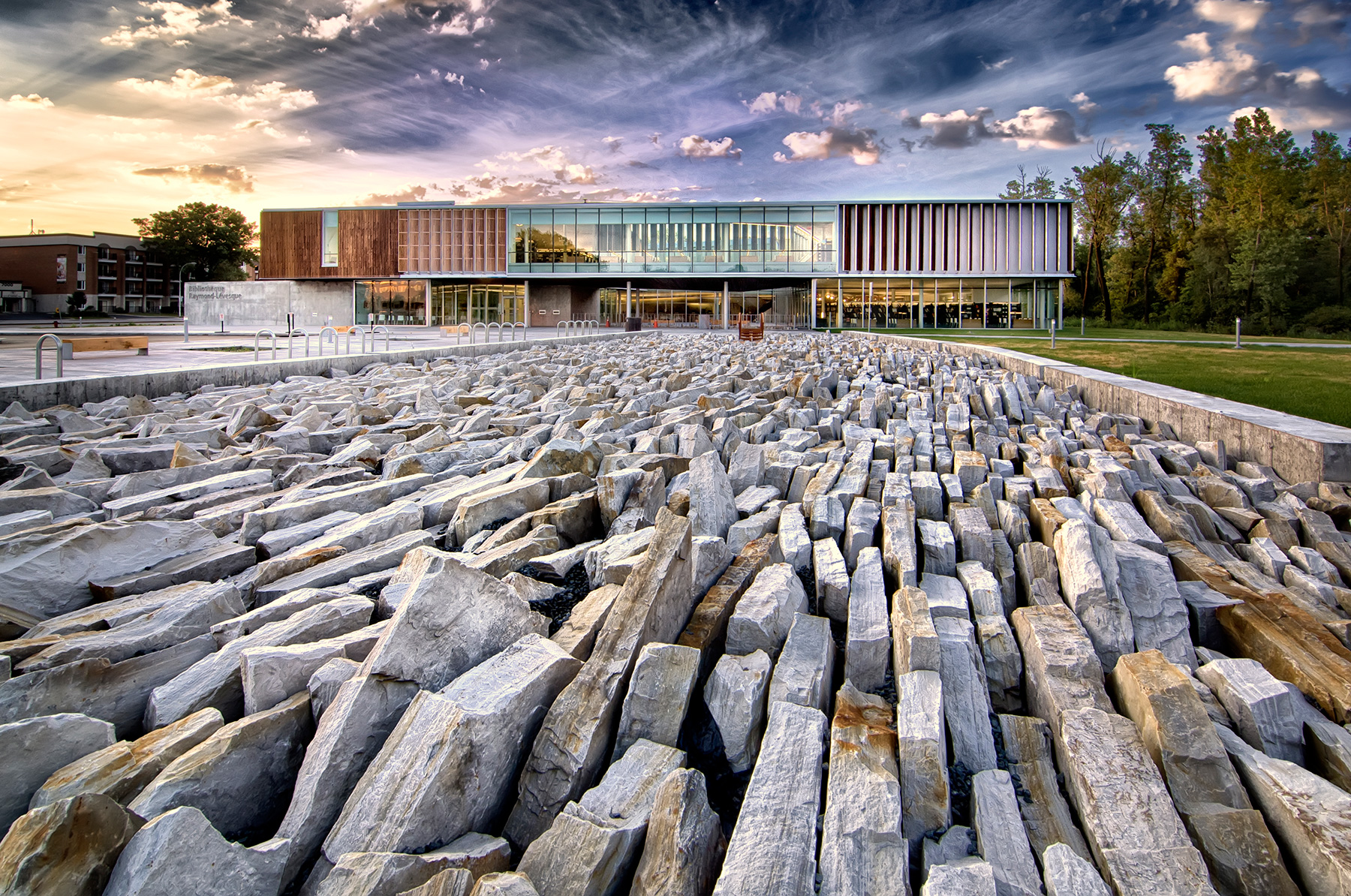
Photo: © Julien Perron-Gagné
As an interface between nature and culture, the new Saint-Hubert library celebrates the exceptional poetic force of its location: the library metamorphoses the forest and materializes the presence of the wind. Beyond the architectural allegory, its geometry speaks of the renewable resources of the earth, the wind, the sun and the rain. From west to east its roof scape is shaped by the prevailing winds.
The giant cut at its center collects the rainwater in a retention basin while the wood blades of its filigree envelope filter the sunlight. The resulting inner courtyard forms the geographic, social, and perceptual heart of the library. The fluidity of the interior spaces around an exterior common space facilitates serendipitous encounters and catalyzes human relations, fulfilling the role of the public library in the 21st century as meeting place for its community.
Jury Comment:
"The building’s response to its unique park setting is greatly appreciated. As a courtyard building, it achieves a scale that is befitting to the park. It also forms a crucible for social interaction, amidst a loose suburban fabric. Light and visual transparency are celebrated in this inventive, economical, and thoroughly rigorous architectural design."

Photo: © Julien Perron-Gagné

Photo: © Marc Cramer

Photo: © Marc Cramer
10. Residence for the Sisters of St. Joseph of Toronto
Shim-Sutcliffe Architects Inc.
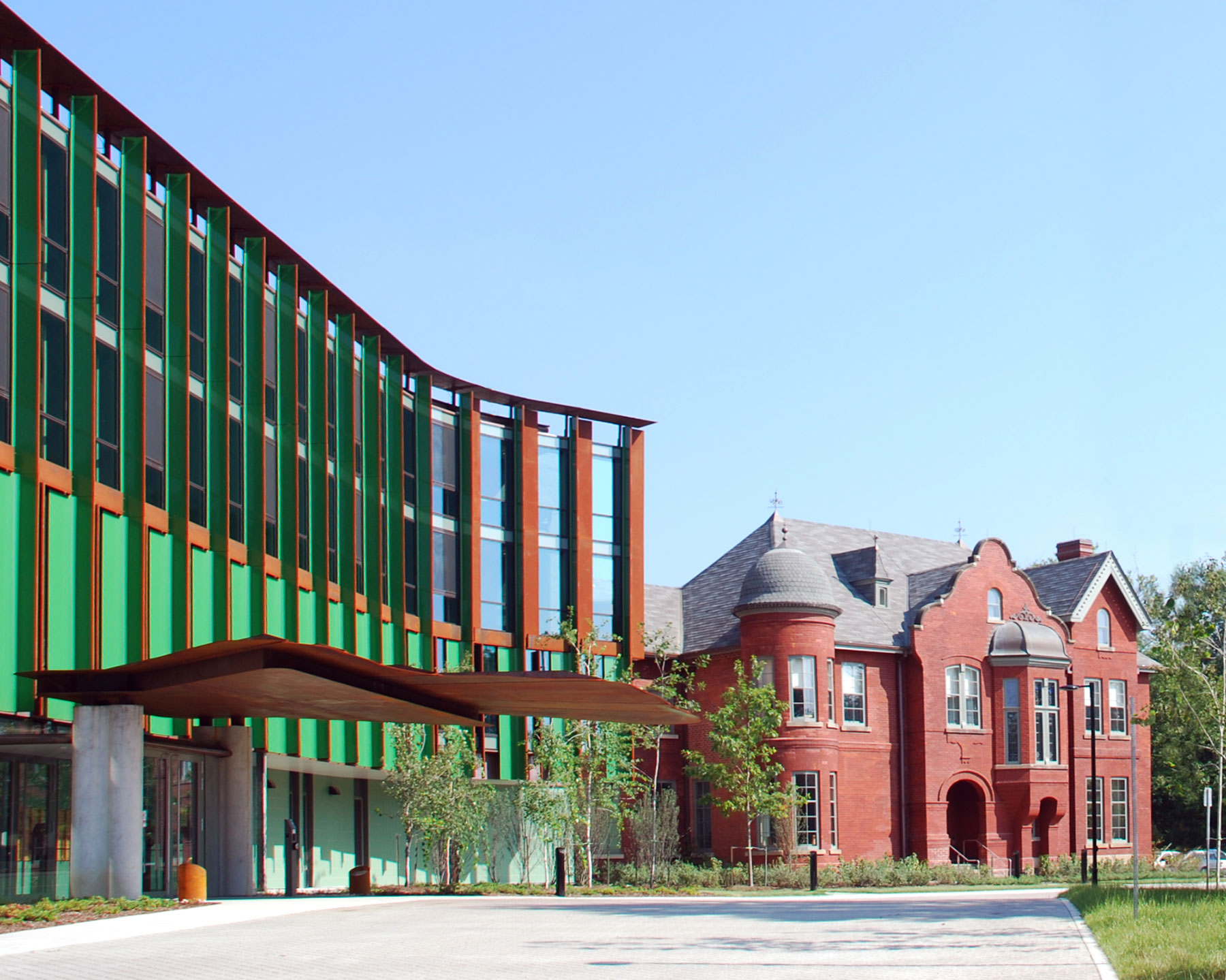
Photo: Courtesy of the Sisters of St. Joseph
The new home for the Sisters of St Joseph forms a sinuous line between the Don Valley to the north and the low-rise urban fabric of the city to the south. The building articulates both individual contemplative life and the community engagement of the sisters’ ministries. It makes relationships to nature and the city to reinforce public and private aspects. These dualities are expressed both in the exterior of the building and its interior spaces.
Jury Comment:
"This project shines for the care that was brought in creating a loving environment for the elderly. The progression of public to private living spaces is underscored by the transition from urban to natural setting, along a narrow site on the edge of a ravine. The choice of materials and the careful attention to detail further add to the notion of this being a life-supporting environment, in the most profound sense of the term."

Photo: Positive Imaging
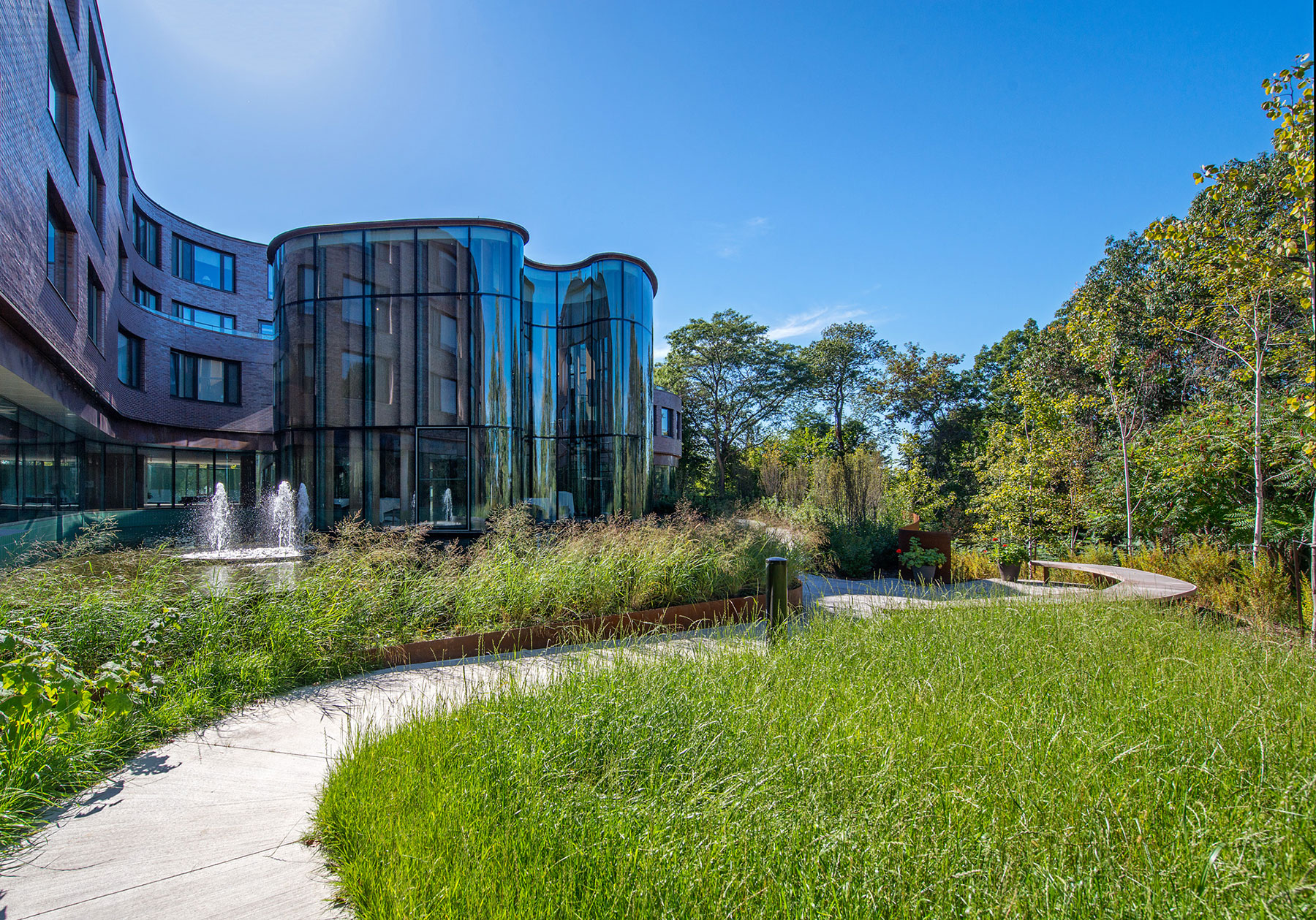
Photo: Bob Gundu
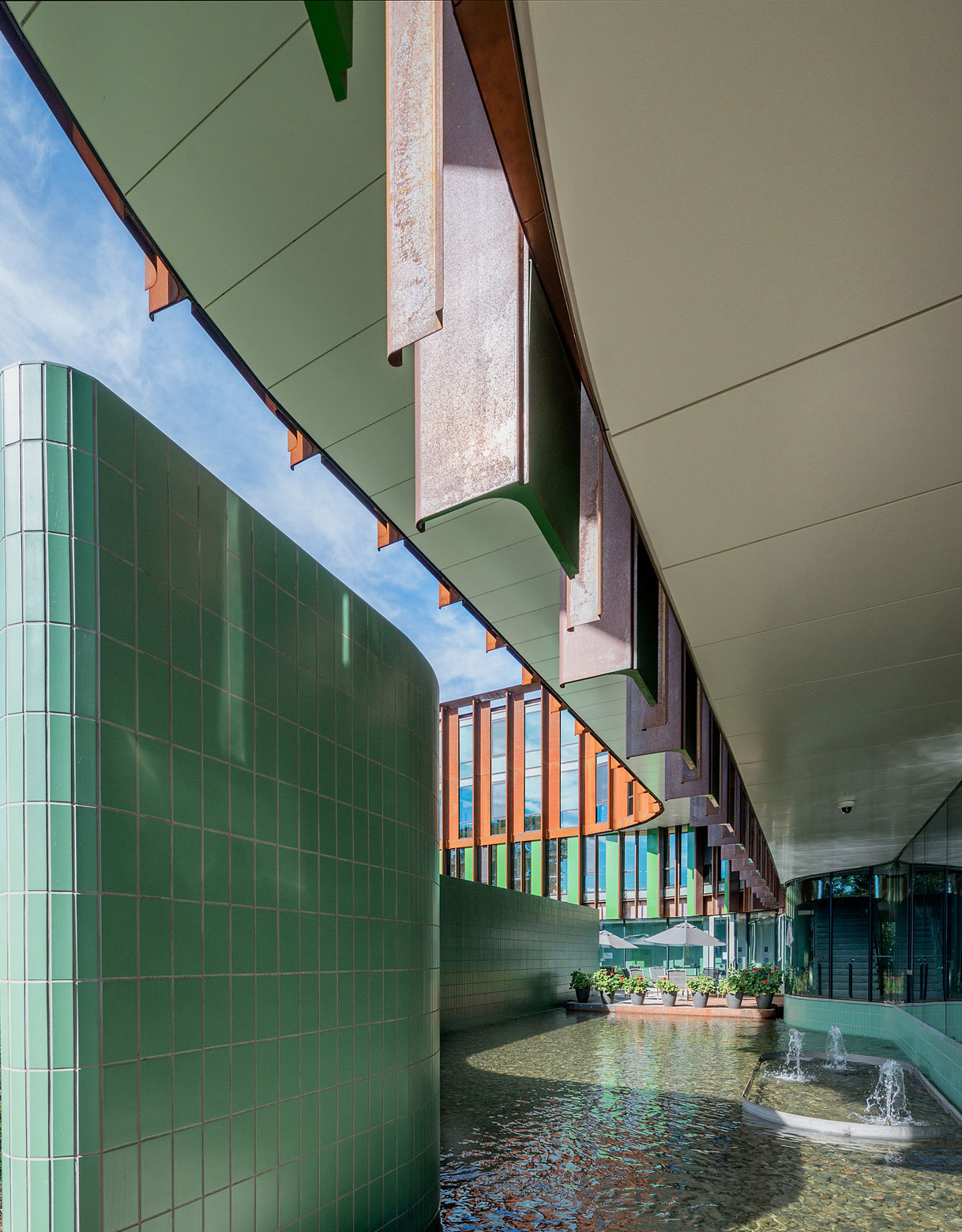
Photo: Bob Gundu
11. The Bloor Gladstone Library, Toronto
RDH Architects Inc. / Shoalts and Zaback Architects Ltd.
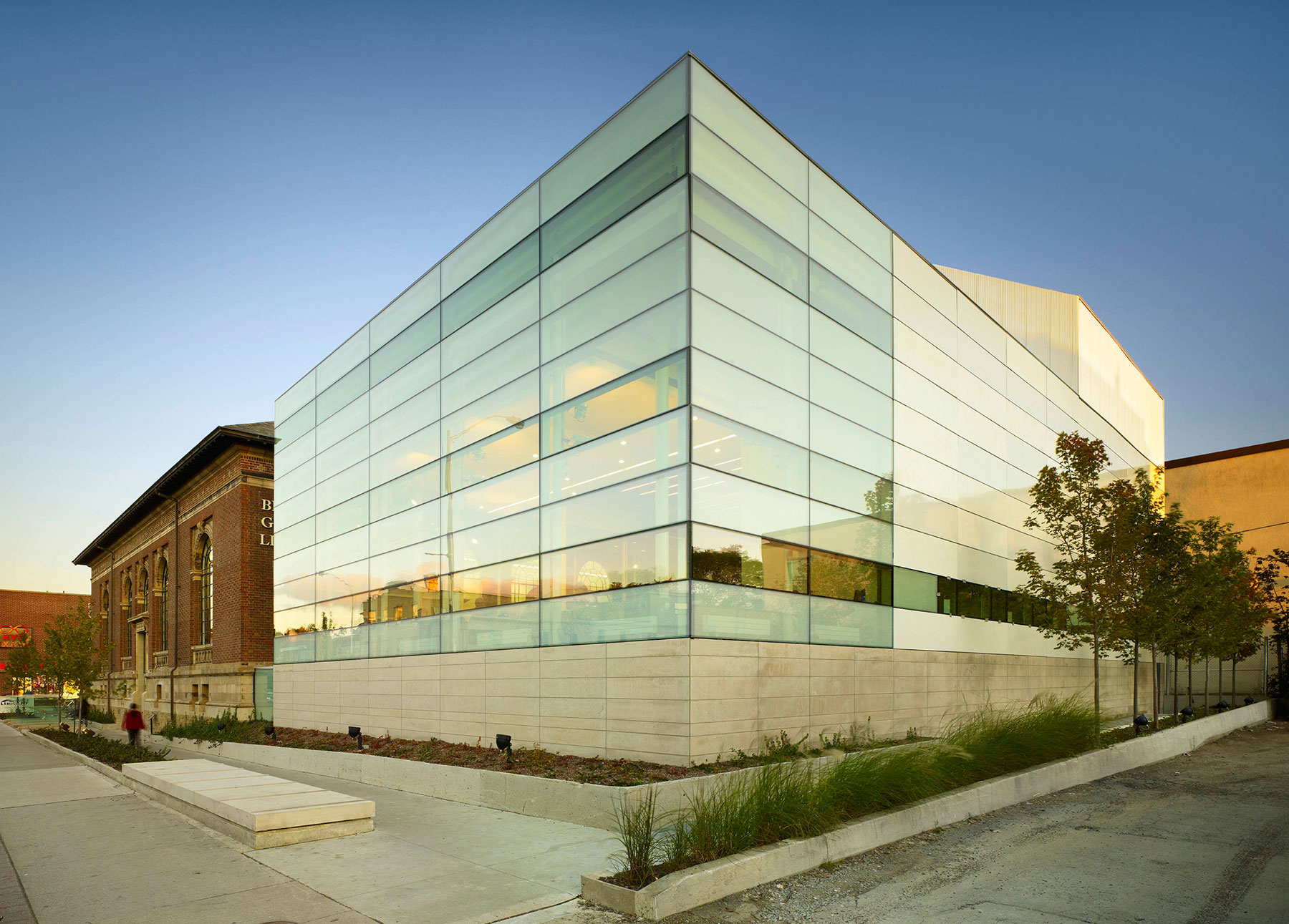
Photo: Tom Arban
The Bloor Gladstone Library project is a renovation and addition to a listed heritage library in downtown Toronto. The architects were commissioned to design for an additional 12,000 square feet, bringing the facilities to a standard consistent with a district library. This project transforms a dilapidated and dysfunctional heritage library into a functioning, interactive, contemporary institution.
The quality of finish, detail and design resolution elevates the community library to a level commensurate with other significant cultural institutions. This enhancement illustrates the fundamental importance of access to information in the world’s largest library system, the Toronto Public Library.
Jury Comment:
"This renovation and expansion of a distinctive historical library stands out for being both creative and respectful. The design re-imagines the entranceway and body of the original structure, adds a minimal glass addition and creates an intimate courtyard in the process."

Photo: Steven Evans Photography
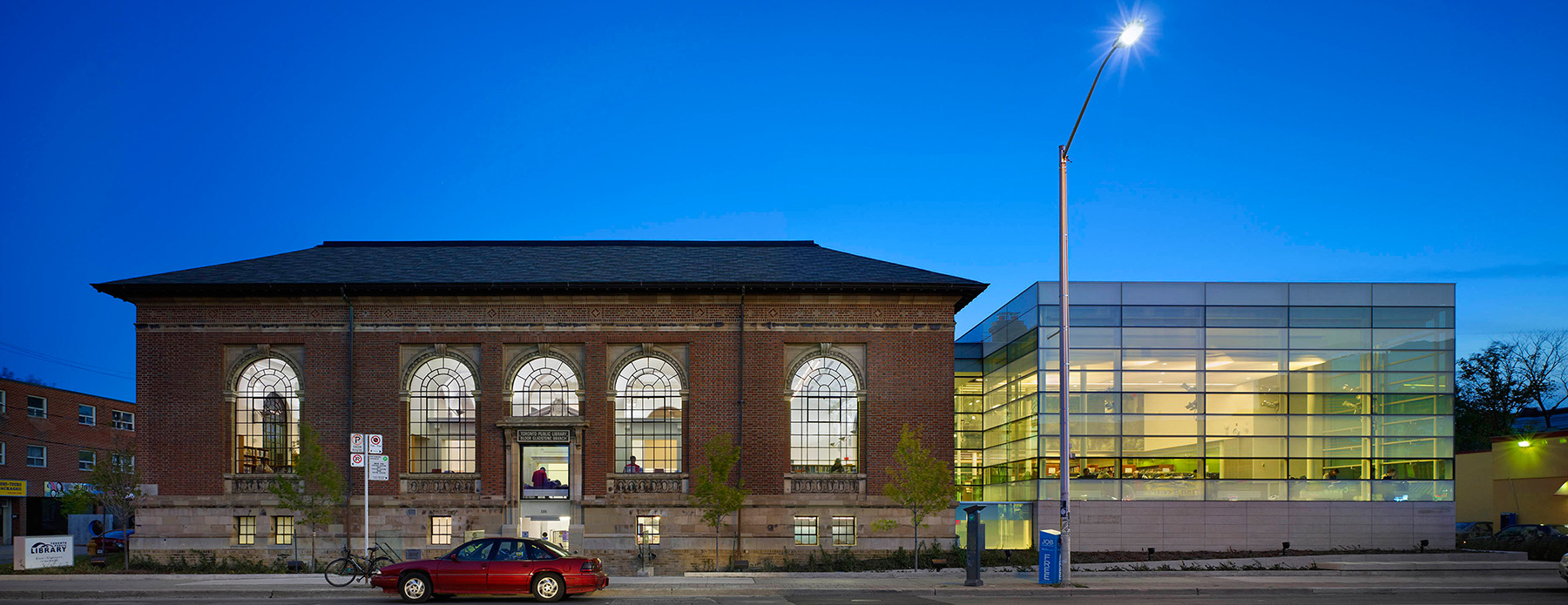
Photo: Tom Arban

Photo: Steven Evans and Tom Arban
12. Tula House, Quadra Island, B.C.
Patkau Architects Inc.
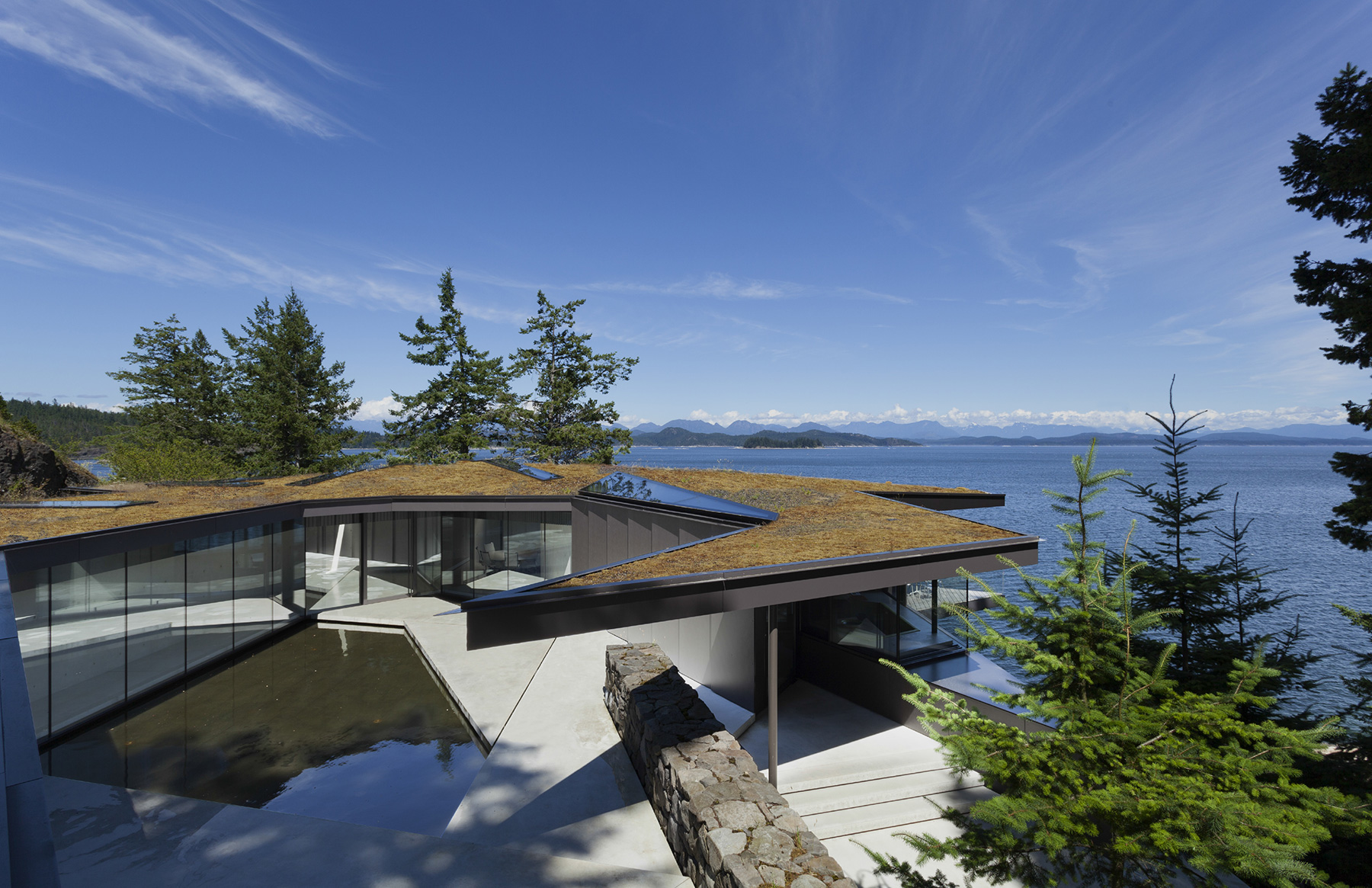
All photos: James Dow/Patkau Architects
Tula House sits on a remote island, at the edge of a cliff, 13 metres above the Pacific Ocean. The house is both primary residence for the clients and headquarters for their private foundation.
The spatial order of the house reflects the casual irregularity of the site’s rock mounds, ocean edges and forest. Exterior walls are clad in black fibre-cement panels, visually receding into forest. A green roof consists of indigenous plants. A steel-framed, wooden deck cantilevers at cliff-edge. An expanse of glass captures the view while glazed apertures in the deck open vertiginously to the ocean below.
Jury Comment:
"Here is a spectacular house for a spectacular site. The jury admired the lightness of the structure on the land and the architect’s sure hand in all aspects of the design and execution. Against the open views and overhanging floors, sea-side, sensory connections are established with groundwater streams and moss-covered rocks, land-side. Light is brought inside to create an atmosphere of repose, punctuated with dramatic moments. This house stands in dynamic harmony with nature."
Related Stories
MFPRO+ News | Jun 3, 2024
Seattle mayor wants to scale back energy code to spur more housing construction
Seattle’s mayor recently proposed that the city scale back a scheduled revamping of its building energy code to help boost housing production. The proposal would halt an update to the city’s multifamily and commercial building energy code that is scheduled to take effect later this year.
Mass Timber | May 31, 2024
Mass timber a big part of Western Washington University’s net-zero ambitions
Western Washington University, in Bellingham, Wash., 90 miles from Seattle, is in the process of expanding its ABET-accredited programs for electrical engineering, computer engineering and science, and energy science. As part of that process, the university is building Kaiser Borsari Hall, the 54,000-sf new home for those academic disciplines that will include teaching labs, research labs, classrooms, collaborative spaces, and administrative offices.
Construction Costs | May 31, 2024
Despite challenges, 2024 construction material prices continue to stabilize
Gordian’s Q2 2024 Quarterly Construction Cost Insights Report indicates that supply chain issues notwithstanding, many commodities are exhibiting price normalization.
University Buildings | May 30, 2024
Washington University School of Medicine opens one of the world’s largest neuroscience research buildings
In St. Louis’ Cortex Innovation District, Washington University School of Medicine recently opened its new Jeffrey T. Fort Neuroscience Research Building. Designed by CannonDesign and Perkins&Will, the 11-story, 609,000-sf facility is one of the largest neuroscience buildings in the world.
Architects | May 30, 2024
AE firm Goodwyn Mills Cawood merges with Southland Engineering
Architecture and engineering firm Goodwyn Mills Cawood (GMC) is further expanding its services through a strategic merger with engineering firm Southland Engineering in Cartersville, Ga.
K-12 Schools | May 30, 2024
Inclusive design strategies to transform learning spaces
Students with disabilities and those experiencing mental health and behavioral conditions represent a group of the most vulnerable students at risk for failing to connect educationally and socially. Educators and school districts are struggling to accommodate all of these nuanced and, at times, overlapping conditions.
MFPRO+ New Projects | May 29, 2024
Two San Francisco multifamily high rises install onsite water recycling systems
Two high-rise apartment buildings in San Francisco have installed onsite water recycling systems that will reuse a total of 3.9 million gallons of wastewater annually. The recycled water will be used for toilet flushing, cooling towers, and landscape irrigation to significantly reduce water usage in both buildings.
Healthcare Facilities | May 28, 2024
Healthcare design: How to improve the parking experience for patients and families
Parking is likely a patient’s—and their families—first and last touch with a healthcare facility. As such, the arrival and departure parking experience can have a profound impact on their experience with the healthcare facility, writes Beth Bryan, PE, PTOE, PTP, STP2, Principal, Project Manager, Walter P Moore.
Urban Planning | May 28, 2024
‘Flowing’ design emphasizes interaction at Bellevue, Wash., development
The three-tower 1,030,000-sf office and retail development designed by Graphite Design Group in collaboration with Compton Design Office for Vulcan Real Estate is attracting some of the world’s largest names in tech and hospitality.
MFPRO+ News | May 28, 2024
ENERGY STAR NextGen Certification for New Homes and Apartments launched
The U.S. Environmental Protection Agency recently launched ENERGY STAR NextGen Certified Homes and Apartments, a voluntary certification program for new residential buildings. The program will increase national energy and emissions savings by accelerating the building industry’s adoption of advanced, energy-efficient technologies, according to an EPA news release.


